
About UsThe Numismatic Bibliomania Society is a non-profit organization promoting numismatic literature. For more information please see our web site at coinbooks.org SubscriptionsThose wishing to become new E-Sylum subscribers (or wishing to Unsubscribe) can go to the following web page link MembershipThere is a membership application available on the web site Membership Application To join, print the application and return it with your check to the address printed on the application. Membership is only $15 to addresses in the U.S., $20 for First Class mail, and $25 elsewhere. For those without web access, write to: David M. Sundman, Secretary/TreasurerNumismatic Bibliomania
Society AsylumFor Asylum mailing address changes and other membership questions, contact David at this email address: dsundman@LittletonCoin.com SubmissionsTo submit items for publication in The E-Sylum, just Reply to this message, or write to the Editor at this address: whomren@coinlibrary.com
BUY THE BOOK BEFORE THE COINYou won't regret it! |
- WAYNE'S WORDS: THE E-SYLUM DECEMBER 14, 2008
- NBS ASYLUM ISSUE DELAYED, BUT GREAT ARTICLES ON THE WAY
- NEW BOOK: CHERRYPICKERS’ GUIDE, 5TH EDITION, VOLUME I
- NEW BOOK: JUDD UNITED STATES PATTERN COINS, 10TH EDITION
- NEW BOOK: A GUIDE BOOK OF THE GUIDE BOOK
- LANGE PUBLISHES COIN BOARD VALUE GUIDE FOR 2009
- BOOK REVIEW: DAS GELD DES TERRORS
- WHERE TO PURCHASE THE SALOON TOKENS OF THE UNITED STATES
- CORNELIUS VERMEULE 1925-2008
- ELLIS EDLOW REMEMBERED
- KRAUSE STANDARD CATALOG EDITOR COLIN BRUCE RETIRES
- MORE ON WORLD MINT REPORTS
- MORE ON THE 1883-O GOLD EAGLE
- SHOULD THE WORDS "SLAB" AND "SLABBED" BE IN THE ENCYCLOPEDIA?
- DID WAYTE RAYMOND SUPPLY WILLIAM LIVINGSTON WITH HIGH-GRADE COINS?
- MORE ON WILLIAM SHELDON
- FRANK'S RESTAURANT MAVERICK MYSTERY SOLVED
- A COSWAY BINDING WITH INLAID PORTRAITS
- QUERY: WORK ON EARLY CAMBODIAN COINS BY GEORGE GROSLIER SOUGHT
- BUY AN OUT-OF-PRINT BOOK FOR CHRISTMAS
- QUERY: CSA SILVER INGOT INFORMATION SOUGHT
- QUERY: NUMISMATIC RESEARCH FUNDING SOUGHT
- ARTICLE HIGHLIGHTS WALTER HUSAK CENT COLLECTION
- QUIZ ANSWER: THE NUMISMATIC SIGNIFICANCE OF TENINO, WASHINGTON
- THE LITERATURE OF U.S. DEPRESSION SCRIP
- EDITORIAL PRESSURE MOUNTS TO ELIMINATE THE CENT
- WAYNE'S NUMISMATIC DIARY, DECEMBER 14, 2008
- NEW CURRENCY AND COINS MUSEUM BEING BUILT IN INDIA
- ZIMBABWE TO ISSUE YET ANOTHER NEW HIGH-DENOMINATION NOTE
- U.S. TREASURY TO ISSUE AUTOMAKER CASHBACK NOTES
- FEATURED WEB SITE: NUMISMATIC CRIMES
WAYNE'S WORDS: THE E-SYLUM DECEMBER 14, 2008
 Among our recent subscribers are Brett Renaud of Bowers and Merena, courtesy of Gar Travis, and Elizabeth Hahn of the American Numismatic Society. Welcome aboard! We now have 1,227 subscribers.
Among our recent subscribers are Brett Renaud of Bowers and Merena, courtesy of Gar Travis, and Elizabeth Hahn of the American Numismatic Society. Welcome aboard! We now have 1,227 subscribers.George Fuld and Ed Krivoniak report being unable to receive The E-Sylum mailings through Verizon. Ed learned that Verizon is blocking email from binhost.com, our mail list provider. I've asked Binhost to sort this out with Verizon - sorry for the inconvenience.
This week we open with news about our print journal, The E-Sylum and announcements regarding several new works of numismatic literature covering topics from pattern coins to saloon tokens and concentration camp money. Topics continued from earlier issues include World Mint Reports and William Sheldon. New queries this week cover subjects such as "CSA" silver ingots, and a work on Cambodian coins.
To learn which numismatic author's favorite tie depicted Mickey Mouse as a pharaoh, read on. Have a great week, everyone!
Wayne Homren
Numismatic Bibliomania Society
NBS ASYLUM ISSUE DELAYED, BUT GREAT ARTICLES ON THE WAY
Numismatic Bibliomania Society President John W. Adams and Asylum Editor David Yoon have announced that that the final issue of the 2008 volume of our print journal will be delayed until early 2009. The delay was due to a sparse backlog of articles, but that situation is being remedied.I understand a number of great new items are in the works or already on Yoon's desk, including articles and notes by Dave Perkins, Joel Orosz, P. Scott Rubin, Bob Leonard, John W. Adams, the new American Numismatic Society Librarian Elizabeth Hahn, and others.
How about making it one of your New Year's resolutions to pitch in and share some of your knowledge and thoughts on numismatic literature and research with an Asylum article?
David Yoon writes:
Biographical notes on significant numismatists of the past. The Asylum has printed quite a few already, but there are certainly many more individuals that haven't received attention. Just at a glance through Bill Malkmus's admirable index, I see that William Sumner Appleton, Isaac F. Wood, Montroville W. Dickeson, George W. Rode, C. W. Betts, and John Hickcox are among the important and/or colorful characters neglected.
Comprehensive reviews of the literature on a particular series or topic. (Thanks to David Fanning for this idea.) We've had recent articles on the Smithsonian's collection and Admiral Vernon medals, but I'm sure everyone who has a favorite series that they collect could say a lot about the past and present references on that series, or about the history of a major collection pertaining to it. This is especially true for things other than coins - medals, tokens, emergency or special purpose scrip, etc. - which often don't have the equivalent of Breen or Krause-Mishler.
In-depth book reviews. The E-Sylum is great for several paragraphs, but sometimes a book calls for a somewhat longer discussion, either because there's so much going on in it or because it's debatable on some important points. Again, I'm sure people have opinions that would be worth sharing in print.
Obituaries. Not something anyone really wants to think ahead on, but when the numismatic community loses someone important, there are times when there's more to be said than a few paragraphs in the E-Sylum. This is especially true if it's someone who has published notable numismatic works that are worth a bit of extra discussion as part of an appreciation of their numismatic achievements.
Google Books. There is a wealth of numismatic literature now available for free on the web via Google, but a guide to what is and isn't (yet) available would be very helpful.
So, how about it? I'll commit to drafting an article about George W. Rode, an important figure in the early days of the American Numismatic Association and the Western Pennsylvania Numismatic Society. Who will step up next?
Remember, The Asylum is a quarterly, edited print journal distributed to paid members of the Numismatic Bibliomania Society. If you're not yet a member, consider joining. Membership information appears in each E-Sylum issue and on our web site at www.coinbookg.org -Editor
NEW BOOK: CHERRYPICKERS’ GUIDE, 5TH EDITION, VOLUME I
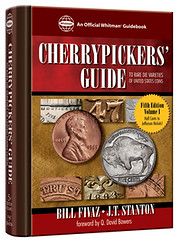 Whitman Publishing, LLC is proud to announce the release of the latest edition of one of America’s most popular coin books: the Cherrypickers’ Guide to Rare Die Varieties, 5th Edition, Volume I, which debuted at the Whitman Baltimore Coin and Currency Convention in November 2008. This volume covers all United States series from half cents through nickel five-cent pieces.
Whitman Publishing, LLC is proud to announce the release of the latest edition of one of America’s most popular coin books: the Cherrypickers’ Guide to Rare Die Varieties, 5th Edition, Volume I, which debuted at the Whitman Baltimore Coin and Currency Convention in November 2008. This volume covers all United States series from half cents through nickel five-cent pieces.The book is the result of many years of cumulative research and finessing by the lead authors, Bill Fivaz and J.T. Stanton, in cooperation with many collectors, scholars, dealers, and others in the numismatic community. It presents information unavailable in any other single source.
The Cherrypickers’ Guide shows you how to “cherrypick” coins—that is, how to examine a seemingly ordinary collection and identify coins with die characteristics that make them rare and valuable. There are hundreds of instances in which an everyday Indian Head cent, Jefferson nickel, or other coin can multiply many times in value if it is of an interesting variety. Examples include repunched dates, doubled mintmarks, and other oddities, often visible without a magnifying glass.
Fivaz and Stanton point out the first places to quickly look on a coin for identification, and offer a guide to rarity and market values in several grades. Accompanying each variety is a narrative relating to its significance.
“Your copy of the Cherrypickers’ Guide can easily pay for itself with a single educated cherrypick,” says Whitman publisher Dennis Tucker. “This edition covers many popular coin series with dramatic die varieties, including Lincoln cents and Buffalo nickels. Dealers and collectors should keep a copy handy at all times.”
An example is pictured on book’s title page: a regular 1936-D Buffalo nickel in MS-60 is worth about $40 to $50. The rare 1936-D known as the “3-1/2 Leg,” in the same grade, is worth almost $20,000.
The fifth edition of the Cherrypickers’ Guide continues the newly simplified Fivaz/Stanton numbering system introduced in the fourth edition, volume II. An appendix cross-references the old system, so collectors and dealers can bring their listings up to date. Included are die varieties for half cents, large cents, Flying Eagle cents, Indian Head cents, Lincoln cents, two-cent pieces, silver three-cent pieces, nickel three-cent pieces, Shield nickels, Liberty Head nickels, Buffalo nickels, and Jefferson nickels.
NEW BOOK: JUDD UNITED STATES PATTERN COINS, 10TH EDITION
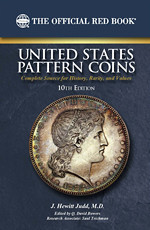 Whitman Publishing, LLC, has released the 10th edition of Dr. J. Hewitt Judd’s classic United States Pattern Coins, updated with new research, market prices, and text by Q. David Bowers and Saul Teichman.
Whitman Publishing, LLC, has released the 10th edition of Dr. J. Hewitt Judd’s classic United States Pattern Coins, updated with new research, market prices, and text by Q. David Bowers and Saul Teichman.For the first time ever, the 10th edition is illustrated in full color.
The hardcover book is a complete resource for the history, rarity, and values of these popular experimental pieces, from 1792 to 2000. “United States Pattern Coins illustrates the trials, struggles, and backstage intrigue that preceded so many of the United States Mint’s regular issues,” says Whitman publisher Dennis Tucker. “This is a fascinating inside look at America’s rarest coins.”
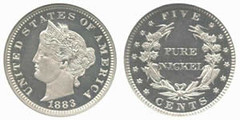 Q. David Bowers, the “dean of American numismatics,” with the aid of preeminent experts in the field, builds upon the strong foundation originally laid by Dr. Judd in 1959.
Q. David Bowers, the “dean of American numismatics,” with the aid of preeminent experts in the field, builds upon the strong foundation originally laid by Dr. Judd in 1959.Saul Teichman, John Gervasoni, Julian Leidman, Andy Lustig, and Laura Sperber are among the researchers and coin dealers who have contributed to the new edition. Hundreds of crisp new high-resolution photographs complement the text, with many images provided by premier institutions and special collections that hold these rare coins.
The book includes appendices that examine pieces struck outside the Mint; pattern coinage metals; and a gallery of unusual sets and curiosities. It includes new research on authenticity, provenance, populations, rarity levels, recent auctions, and retail values. Gold and aluminum pieces in particular have seen increased market activity recently, while famous “story coins” such as the Amazonian gold and silver pieces, Washlady coins, and Shield Earring silver pieces remain highly popular.
... and Mary Counts, president of Whitman Publishing:
NEW BOOK: A GUIDE BOOK OF THE GUIDE BOOK
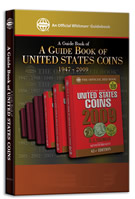 Whitman Publishing entered the field of numismatic publishing in 1934. In 2009 we celebrate our 75th year by rolling out a book about the hobby’s leading annual reference—the Guide Book of United States Coins, popularly known as the “Red Book.”
Whitman Publishing entered the field of numismatic publishing in 1934. In 2009 we celebrate our 75th year by rolling out a book about the hobby’s leading annual reference—the Guide Book of United States Coins, popularly known as the “Red Book.”The Red Book is popular as a collectible in its own right. Why create a guide book about the Guide Book?
The Red Book, which has been a cornerstone of the hobby since it debuted in late 1946, has become a collectible itself. Many coin collectors save a copy each year, while striving to hunt down the elusive early editions and rare errors and varieties.
To aid other collectors, researcher and longtime hobbyist Frank J. Colletti has written the definitive guide to the scarlet tome: the Guide Book of the Official RED BOOK of United States Coins.
You don’t need to be a confirmed “Numismatic Bibliophile” to love this book—just a fan of the world’s greatest pastime! It’s unlikely that any coin collector active today has not heard of the hobby’s beloved “Red Book.” Readers have bought more than 21 million copies since 1946, making it one of the best-selling nonfiction books in the history of American publishing.
The Guide Book of the Official RED BOOK of United States Coins offers a history of coin price guides, leading up to the best-selling numismatic reference of all time. Colletti explores the foundation laid by hobby legend R.S. Yeoman, and then studies each Red Book issued since 1946. Regular editions, special editions, authorized overprint editions, and amazing errors are all examined in detail, with market values given for various grades. Colletti looks in-depth at the “Blue Book,” too (the Handbook of United States Coins). He tells what to look for and how to build and care for your collection of Red Books. He also discusses Red Book–related medals and other collectibles.
The Guide Book of the Official Red Book of United States Coins is chock-full of behind-the-scenes photographs from Whitman Publishing archives. Along the way, you’ll enjoy a wealth of old advertisements, vintage photographs of the personalities involved in the book, and historical hobby memorabilia. Kenneth Bressett, Q. David Bowers, and other famous hobbyists offer their personal recollections. In pictures and words, it’s like sitting down with friends and learning all the behind-the-scenes stories, the legends, and the lore of more than 60 years of American numismatics.
Author Frank Colletti explores these collectibles in addition to the Red Book itself. If you collect or deal in rare coins, numismatic literature, or collectible books—if you love learning about the hobby’s famous dealers, collectors, and researchers—if you want to add to your own collection of Red Books, or find out how much they’re worth—you’ll be delighted with the Guide Book of the Official RED BOOK of United States Coins.
By Frank J. Colletti.
Foreword by Q. David Bowers.
Introduction by Kenneth Bressett.
304 pages; full color; 6 x 9; softcover. Retail $18.95.
LANGE PUBLISHES COIN BOARD VALUE GUIDE FOR 2009
In addition, David W. Lange has prepared a list of Errata & Addenda for his 2007 book. Also now available are his latest price list of antique Coin Boards for Sale #107 and his newsletter Coin Board News #7.
All of these publications will be sent to anyone requesting them by email or by sending a self-addressed envelope to his post office box address with 59 cents postage affixed. Collectors and dealers are invited to view his website featuring a gallery of antique coin boards, as well as information about Lange's sales of coin boards and his various numismatic books.
David W. Lange
POB 110022
Lakewood Ranch, FL 34211-0022
941-586-8670
For more information, see: www.coincollectingboards.net
Also, not mentioned in the story about Peter Funt's column regarding retention of the "penny" was that Peter is the son of Allen Funt of Candid Camera fame. When that show was revived a few years ago with Peter and Dena Eastwood (Clint's wife) as co-hosts, the new episodes were shot in and around Monterey.
BOOK REVIEW: DAS GELD DES TERRORS
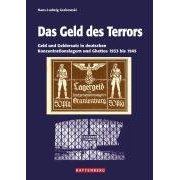 A new book titled Das Geld des Terrors: Geld und Geldersatz in deutschen Konzentrationslagern und Gettos 1933 bis 1945 went on sale October 2008 in Germany. In English: The Money of the Terror: Money and Money Replacement in German Concentration Camps and Ghettos 1933-1945. The book is written by Hans-Ludwig Grabowski and is published by Battenberg Verlag, Regenstauf. I obtained a copy last week from a dealer in Hamburg that listed it on eBay.
A new book titled Das Geld des Terrors: Geld und Geldersatz in deutschen Konzentrationslagern und Gettos 1933 bis 1945 went on sale October 2008 in Germany. In English: The Money of the Terror: Money and Money Replacement in German Concentration Camps and Ghettos 1933-1945. The book is written by Hans-Ludwig Grabowski and is published by Battenberg Verlag, Regenstauf. I obtained a copy last week from a dealer in Hamburg that listed it on eBay. The 456 page hardbound book is written in German with numerous color photos of Concentration Camp and Ghetto scrip along with many documents artifacts and pictures of the camps. The fantastic collection of scrip illustrated is primarily from the collection of Wolfgang Haney of Berlin.
There are 27 chapters, each one representing a camp or ghetto. The last chapter is of particular interest with information and illustrations of fantasy and counterfeit issues. The chapters begin with a rather detailed discussion of the history and details of the operation of the camps and ghettos. The next section of the chapter contains illustrations and description of scrip from that camp including varieties. There are many pictures of scrip that have probably never been seen before including a 1 RM note from Natweiler. This note is attributed to the Charlton Meyer Jr. collection.
There is also a section on anti-Semitic notgeld and message over printed notes. Prices are listed for lower priced issues and the R rarity scale similar to the Albert Pick Das Lagergeld book with R being rare and RRRR probably unique.
I found this book to be an excellent resource (especially if you can read German) and a must along with Silent Witness by Ray and Steve Feller for everyone interested in this area of military numismatics. Even if German is not your second language the scrip listings are pretty easy to understand. The fixed price of the book in Germany is 39,90 EUR. Shipping to the USA ranges from 9-13 EUR. German Amazon and many German book dealers on EBay have it for sale.
To order from Amazon.de, see: Das Geld des Terrors: Geld und Geldersatz in deutschen Konzentrationslagern und Ghettos 1933 bis 1945 (Gebundene Ausgabe) (www.amazon.de/Das-Geld-Terrors-Geldersatz-Konzentrationslagern
/dp/3866460406)
WHERE TO PURCHASE THE SALOON TOKENS OF THE UNITED STATES
Regarding the book mentioned last week by Duane Feisel ( The SALOON TOKENS OF THE UNITED STATES), Del Cushing writes:THE BOOK BAZARRE
CORNELIUS VERMEULE 1925-2008
 Cornelius C. Vermeule III, who over four decades as curator of classical antiquities at the Museum of Fine Arts in Boston built a reputation for astute acquisitions, prodigious scholarship and exuberant eccentricity (his office had a working model of Cyprus’s national railroad), died on Nov. 27 in Cambridge, Mass. He was 83.
Cornelius C. Vermeule III, who over four decades as curator of classical antiquities at the Museum of Fine Arts in Boston built a reputation for astute acquisitions, prodigious scholarship and exuberant eccentricity (his office had a working model of Cyprus’s national railroad), died on Nov. 27 in Cambridge, Mass. He was 83.Dr. Vermeule (the last syllable is pronounced “mule”) took charge of Greek and Roman art in 1956 and breathed life into a classical department then rivaled in the United States only by that of the Metropolitan Museum of Art in New York. He added new lighting, new cases and a new, eager staff; dreamed up popular exhibitions like “Romans and Barbarians”; acquired hundreds of treasures; and even donated important artifacts himself.
“He blew through those musty old galleries like a fresh wind,” Michael Padgett, curator of ancient art at the Princeton University Art Museum, said in an interview Thursday.
In an interview Friday, Carlos A. Picon, head curator of Greek and Roman art at the Met, lauded Dr. Vermeule’s success in working with his staff to produce what he called an unmatched body of literature on Boston’s classical collection. Dr. Vermeule’s own bibliography listed 800 works and filled 60 printed pages.
As a collector, Dr. Vermeule landed prizes like an exquisite Minoan gold double-ax, and two large fifth-century B.C. kraters, a type of ancient Greek jar. Jerome J. Pollitt, a professor of classical art and archaeology at Yale, said Dr. Vermeule had understood the provenance of art in uncanny detail, especially that from England’s country homes.
“It was almost as if he had been alive since the 17th century,” he said in an interview Friday.
Dr. Vermeule’s personal style bristled with an idiosyncrasy reminiscent of those old-style gentlemen curators who intimately knew their entire collection, hobnobbed with museum trustees, courted rich donors and disdained talk of trivialities like salary. (He drew the line at disdaining pay, explaining that he had too many mouths to feed, particularly those of his Dalmatian dogs, each named for a Roman emperor or empress.)
He favored a single frayed suit, a tie depicting Mickey Mouse as a pharaoh and beat-up white sneakers with black spots in honor of his Dalmatian pack, numbering a half dozen at its peak.
Dr. Vermeule’s own gifts to the museum, including a significant Etruscan statue, were often given under pseudonyms, one being Sir Northwold Nuffler.
Cornelius Clarkson Vermeule III was born on Aug. 10, 1925, in Orange, N.J. He started collecting ancient Roman coins at 9. He interrupted his studies at Harvard to serve in the Army as a Japanese interpreter, then returned to earn his bachelor’s degree in 1949 and master’s in 1951. The University of London awarded him a doctorate in 1953.
To read the complete article, see: Cornelius C. Vermeule III, a Curator of Classical Antiquities, Is Dead at 83 (www.nytimes.com/2008/12/09/arts/design/09vermeule.html?
ref=obituaries)
ELLIS EDLOW REMEMBERED
I spoke with a couple of dealers around town and one suggested that I speak with Ellis, who asked me if Mr. X was at the meeting. I told him that he was and he suggested that I call Mr. X, a wealthy collector in the area and demand that he return my two coins. I was nervous but did as suggested. Mr. X denied having the coins, but since I told him that I would call his elderly mother if he did not return them, I had him over a barrel. He came to see me and gave me equal value in other coins. It seems Mr. X was a kleptomaniac.
I began a collection of Washington D.C. currency later and eventually purchased Ellis' fantastic collection of obsolete currency. It also happened that Mr. X had a collection of D.C. obsolete currency also and I purchased that later from an intermediary. Subsequently, I purchased Ellis' collection of D.C. National Bank Notes. He was a true gentleman and I always enjoyed visiting him.
He suffered a stroke during a coronary operation and retired to Florida, which is where I purchased the nationals. I actually traded him a Florida obsolete collection that was assembled by Jerry Tralins, a Florida dealer.
Ellis assembled over the years a beautiful collection of coins, mostly proofs from 1858 on and they are still owned by a family member, whom I speak with from time to time.
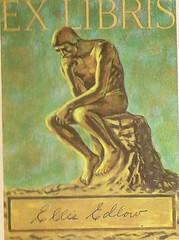 I knew Ellis Edlow in the early 1950s when I was in the Air Force stationed near Washington, DC. We were both members of the Washington Numismatic Society. I remember one incident we were meeting for some committee or other at Ellis' home in the winter. It snowed that day and the evening meeting was cancelled. Since it was impossible to reach me by phone I was unaware of the cancellation and showed up alone at his door. He invited me in however and I had him all to myself for an evening of conversation.
I knew Ellis Edlow in the early 1950s when I was in the Air Force stationed near Washington, DC. We were both members of the Washington Numismatic Society. I remember one incident we were meeting for some committee or other at Ellis' home in the winter. It snowed that day and the evening meeting was cancelled. Since it was impossible to reach me by phone I was unaware of the cancellation and showed up alone at his door. He invited me in however and I had him all to myself for an evening of conversation. As I do in every numismatist's home, I look at their library. Ellis had only three numismatic books as I recall in a living room bookcase. His numismatic library certainly must have grown over the years to require a bookplate as illustrated in last week's E-Sylum. Ellis was a great numismatist.
Interestingly, I knew him as Ellis Edlowitz. The family had changed their name -- I do not know what year. I guess they thought "Edlowitz" was too ethnic. I found it rather charming. He wrote me a letter once after I addressed a letter to him under his prior name, he informed me the family had shortened their name. I resisted the temptation to answer him as "Dick John."
KRAUSE STANDARD CATALOG EDITOR COLIN BRUCE RETIRES
 Standard Catalog of World Coins senior editor Colin R. Bruce II retired Oct. 31 at the age of 69 after more than 34 years in the Krause Publications' catalog department.
Standard Catalog of World Coins senior editor Colin R. Bruce II retired Oct. 31 at the age of 69 after more than 34 years in the Krause Publications' catalog department.He was hired in April 1974 by Clifford Mishler to take over and improve upon the pioneering work created by Mishler, Chet Krause and other staff members. The Standard Catalog is now in its 36th edition and other volumes break the information down by centuries.
Of his time as head of the catalog department, Bruce said, "My job here was so hobby-related and enjoyable that I could easily handle the long hours before deadlines and the weekends at shows here and abroad."
"We are forever indebted to Colin for the pioneering work he did building the KP world coins database into the best in existence," said KP numismatics publisher Scott Tappa. "We intend to honor Colin's legacy by continuing to offer coin collectors the most comprehensive catalog and price guide available to enthusiasts worldwide."
Senior market analysts Tom Michael and George Cuhaj will take over Bruce's catalog duties.
To read the complete article, see: Standard Catalog Editor Retires (http://www.numismaster.com/ta/numis/Article.jsp?ad=article&ArticleId=5862)
MORE ON WORLD MINT REPORTS
Jan Moens of Dilbeek, Belgium writes:The Swiss Government published detailed data on the activities on its Mint (in Bern) on a yearly basis, although not in a separate report, but in a general statistical report on the activities of the Federal Government. I am not aware of Mint reports for Germany, although I suppose, like for Switzerland, that data should be available in more general official statistical publications.
Obviously also the annual reports of most central banks contain information on monetary affairs, including in some cases mintage figures.
And the procès-verbaux of the conferences organised by the Latin Monetary Union between 1865 and 1921 also often contain detailed statistical data. Actually, the reports by the Mint in Paris since 1896 were published in order to comply with the stipulations of the agreement of this monetary union, by which member states were obliged to exchange statistical information on coinage matters; first, this information was exchanged between the ministeries of foreign affairs only, and was not made public, but later on, it was decided to have them published with the help of the French Government, leading, as said, to the publication of the annual reports in 1896.
MORE ON THE 1883-O GOLD EAGLE
Rich Kelly & Nancy OliverThe 1883 is quite an interesting coin, with its miniscule mintage of just 800 pieces, and from all the resources we have researched there has been little, if any, information to support its low production. We decided to delve into it, and came up with some interesting facts, as well as some theory because the records are scant in the National Archives.
Anyway, we are hoping that the article will be published and this new information can be shared by all.
SHOULD THE WORDS "SLAB" AND "SLABBED" BE IN THE ENCYCLOPEDIA?
This is definitely a case of "mo betta". "Slab" is in common use and has very definite numismatic meanings. I already see a newcomer to our hobby looking it up and being disappointed not to find it there. If Dick Johnson's work truly aims to be the definitive reference in its class- the last word on numismatic terminology, it MUST contain any word with even the most oblique or passing significance to numismatics.
 I for one would happily pay for such a book, even if it ran to a couple of hundred bucks. I already have a few numismatic dictionaries and encyclopedias in my library (mostly for Latin American and World material) and am constantly disappointed by the dearth of content or minimality of definition when there is a word I need to look up. One notable exception is Humberto Burzio's Diccionario de la Moneda Hispanoamericana, Santiago, 1958, an erudite "must have" in any numismatic library.
I for one would happily pay for such a book, even if it ran to a couple of hundred bucks. I already have a few numismatic dictionaries and encyclopedias in my library (mostly for Latin American and World material) and am constantly disappointed by the dearth of content or minimality of definition when there is a word I need to look up. One notable exception is Humberto Burzio's Diccionario de la Moneda Hispanoamericana, Santiago, 1958, an erudite "must have" in any numismatic library.If I can help with Dick's valuable effort, I'll be glad to do so, within my limited abilities. If a legitimate argument can be made for including a term, such ought always to outweigh any argument for leaving it out.
DID WAYTE RAYMOND SUPPLY WILLIAM LIVINGSTON WITH HIGH-GRADE COINS?
Dave Hirt writes:The question remains, however, as a second or third tier dealer, where was he getting all these uncirculated & proof coins? While thinking about this, I remembered something that I read a long time ago (I don't remember where) that Wayte Raymond had an arrangement with a dealer in the 1930's, supplying him with coins to sell, but it did not work out. If Livingston was that dealer, it would explain the quality material he was offering.
MORE ON WILLIAM SHELDON
Dave Bowers notes:
Denis Loring writes:
Your Editor missed another typo in Dick Johnson's submission, and a couple readers picked up on it.
Arthur Shippee writes:
Roger Burdette writes:
Ron Guth adds:
Of particular interest is a citation from Early American Cents: 'For generations American schoolboys bought, sold, swapped, or swiped old coppers. Some of these boys, especially in old age, have returned to the early enchantment, there to forget or condone the singular incompatibility between human dreams and fulfillments.' (p. 5)
What is this but a description of Sheldon, himself, who fulfilled his professional dreams but not himself?"
THE BOOK BAZARRE
FRANK'S RESTAURANT MAVERICK MYSTERY SOLVED
Wendell Wolka writes:

Tom Carson of Chattanooga, Tennessee adds:
A COSWAY BINDING WITH INLAID PORTRAITS
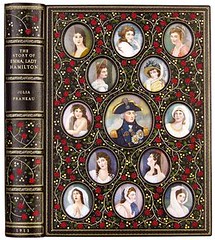 The Story of Emma, Lady Hamilton
The Story of Emma, Lady Hamilton by Julia Frankau
This month, one of our features is about Cosway bindings. Our pick of the month is this fantastic and gorgeous example with 13 inlaid portraits. Horatio Nelson is in the center.
Publisher: Macmillan and Co., Limited, London, 1911
Publication Date: 1911
Binding: Hardcover
To read the complete article, see: The Avid Collector
From the bookseller's description:
QUERY: WORK ON EARLY CAMBODIAN COINS BY GEORGE GROSLIER SOUGHT
I've matched the descriptions to coins in my own collection (with some past email assistance from Scott Semans) but I want to see which varieties Groslier actually picked. Any assistance will be greatly appreciated and will land the contributor(s) into my own Cambodian catalog's List of Contributors.
BUY AN OUT-OF-PRINT BOOK FOR CHRISTMAS
I went searching on ABE books and found Omoo, A Narrative of Adventures in the South Seas in stock at a bookseller half a state away. Gosh, that sounds like a great read, even though it was published in 1892. A quick email and a credit card number consummated the sale.
That was more fun for me than the big box Hero Guitar for four grandsons that shopper-savvy wife found that had been sold out in every toy store in a 50-mile radius. She found it in a game store miles from a mall that had just received a tiny shipment of ten that hadn't sold out yet. It must have been on every teenager's Want List this season like a Cabbage Patch doll was some years ago. But every family has to have at least one Hot Toy of the Year.
My book purchase was less than the state sales tax for the big-box purchase. But I'll wager it gives more pleasure to my grandson.
Happy Reading, Matthew! Can I make a book collector of you?

QUERY: CSA SILVER INGOT INFORMATION SOUGHT
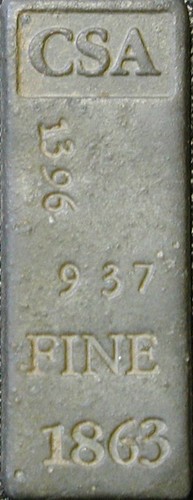

QUERY: NUMISMATIC RESEARCH FUNDING SOUGHT
Serge Pelletier writes:Thanks in advance,
Prof. Angel Navarro-Zayas
| FEATURED IN OUR JANUARY 10, 2009 NEW YORK PUBLIC AUCTION SALE JONTHAN SWIFT'S 1724 DEFENCE OF THE CONDUCT OF THE PEOPLE OF IRELAND IN THEIR UNANIMOUS REFUSAL OF MR. WOOD'S COPPER-MONEY GEORGE FREDERICK KOLBE Email: GFK@numislit.com Tel: (909) 338-6527 | 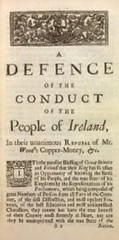 |
ARTICLE HIGHLIGHTS WALTER HUSAK CENT COLLECTION
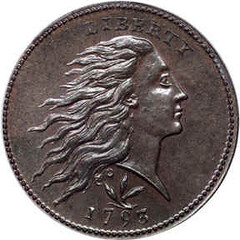 At one time or another, we have all dreamed of turning pocket change into millions. A California man actually made it happen last February, though, when he sold a collection of 301 pennies for $10.7 million. Of course, they were not just any pennies. The set contained virtually every variety and subvariety of U.S. cent minted in the classic period between 1793 and 1814. Van Nuys resident Walter J. Husak had been assembling his early coppers for 28 years and estimated that they cost him a little over $5 million. That is a lot for a coin collection, but it ultimately netted him a profit of close to $200,000 per year and that is a return anyone can appreciate.
At one time or another, we have all dreamed of turning pocket change into millions. A California man actually made it happen last February, though, when he sold a collection of 301 pennies for $10.7 million. Of course, they were not just any pennies. The set contained virtually every variety and subvariety of U.S. cent minted in the classic period between 1793 and 1814. Van Nuys resident Walter J. Husak had been assembling his early coppers for 28 years and estimated that they cost him a little over $5 million. That is a lot for a coin collection, but it ultimately netted him a profit of close to $200,000 per year and that is a return anyone can appreciate.As with any investment-minded collector, Husak was doubtless torn between the desire to put together a complete collection of early cents and the hope that they would increase in value. He chose the path that usually finds the best equilibrium between aesthetic satisfaction and monetary gain by going high end. He acquired attractive specimens in the most advanced grades possible, very often locating the finest known examples of given varieties.
Husak began collecting coins at the age of twelve, showing early acumen when he bought six Indian head pennies for $12 and then immediately sold the single valuable piece for $15. He disposed of his early collection to buy a car and make a down payment on a house, but re-entered the hobby in 1980 with the purchase of an 1804 large cent.
The need to pay off some real estate debt finally led to Husak's decision to sell and he admitted that he was "scared to death" of losing money on the collection. He need not have been. The Heritage sale represented a one-in-a-lifetime opportunity to bid on many of the coins, and quite a few realized multiples of previous records.
Way to go, Walter! Investment-oriented collectors salute you.
To read the complete article, see: Money winners of 2008: Walter Husak cashes in on rare pennies (http://www.bloggingstocks.com/2008/12/14/money-
winners-of-2008-walter-husak-cashes-in-on-rare-pennies/)
QUIZ ANSWER: THE NUMISMATIC SIGNIFICANCE OF TENINO, WASHINGTON
Regarding the numismatic significance of Tenino, Washington, Tom DeLorey coyly writes:Pete Smith writes:
Del Cushing writes:
The favorite story of the town's name is that comes from the train engine which ran through the town. Its number was 10-9-0. There are other versions of where the name comes from but the train story is what is featured on one of the commemorative wooden money notes.
Here's what the City of Tenino has to say on its web site:
To read the complete history of Tenino, WA, see: A Brief History of Tenino," By Art Dwelley (www.ci.tenino.wa.us/history_by_dwelley.htm)
The Tenino Chamber of Commerce met to meet the emergency and agreed to issue scrip to permit the depositors to assign 25% of their bank accounts to the Chamber. The printing press at the Independent office was soon running out of assignment forms and depositors signed for definite amounts of money within the 25% limitations. The printing of $1.00, $5.00 and $10 denomination scrip was done on engraved pieces the size of paper money then in use. The 25 cent denomination was the yellow bond paper without any fancy border. Trustees of the Chamber of Commerce Committee, F.W. Wichman, D.M. Major and A.H. Meyers, signed each piece. They agreed to redeem the certificates “During the Process of Liquidation of the Citizens Bank of Tenino.” This scrip printed in December, 1931 totaled $3,255, of which $1,279 was circulated. Eventually the Chamber redeemed $1,079.75 of this scrip.
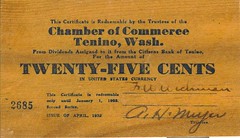
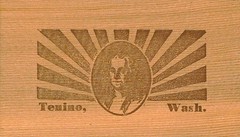
Some samples of “slice wood”, a new printing material, had been received from Albert Balch of Seattle, who was promoting it for Christmas cards and other items. This was made in a special machine at Aberdeen by a man named Eckersley. Sitka Spruce and Port Orford and red cedar were used. The first pieces were flimsy sheets of 1/80th of an inch thick. The 25 on hand were sufficient to put Tenino in the wooden money business. Later the slices were sandwiched with a paper in between. One issue of a thousand even carried a “watermark” reading “Confidence makes good; Money made of wood”, which could be seen by holding it up to the light. This was supposed to guard against counterfeiting.
The publicity of Tenino Wooden Money began to snowball in February, 1932, the old Seattle Star carrying the story early that month, followed by the Tacoma News-Tribune, Oregonian, Seattle P-I and others. The Halls of Congress heard of the unique method of meeting the money shortage and in March it was featured in the Congressional Record. Thousands of stories and comments appeared over the world in newspapers and magazines. Orders from collectors and souvenir hunters came in increasing demand and eight issues were printed through 1933, mostly in 25 cent denominations, but also in 50 cent and $1.00. In all $10,308 worth of wooden money was issued of which about $40 was redeemed by the Chamber of Commerce. In April, 1935, business people used small wooden fifth cent tax tokens due to a state shortage of tokens. Like the original wooden money, they are now quite valuable.
To read the complete article, see: The Complete Story of Tenino Wooden Money By Don Major, from the Thurston County Independent, Feb. 19, 1965 (www.ci.tenino.wa.us/wooden_money.htm)
THE LITERATURE OF U.S. DEPRESSION SCRIP
The Kappen-Mitchell book Depression Scrip of the United States (mentioned above) has long been one of my favorite numismatic books, even though its coverage is incomplete. Subtitled Period of the 1930s States A thru I the book covers Alabama through Iowa. As Neil Shafer noted in the Preface to his 1984 Standard Catalog of Depression Scrip of the United States, "A second book was planned to complete the state listings, but somehow it was never finished."The Kappen-Mitchell book was superseded as a catalog by the 1984 Mitchell-Shafer work. But Kappen-Mitchell remains quite useful for the background information it contains on many of the scrip issues listed.
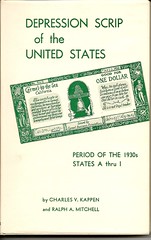
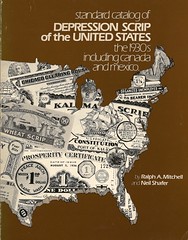
I had forgotten all about contributing to the book. I didn't do much, but had sent Neil a list of the notes in my own meager collection. Mine is a presentation copy, complete with an example of actual Depression Scrip. Neat!
QUICK QUIZ: Who can name another book on paper money which includes an actual example of the item catalogued?
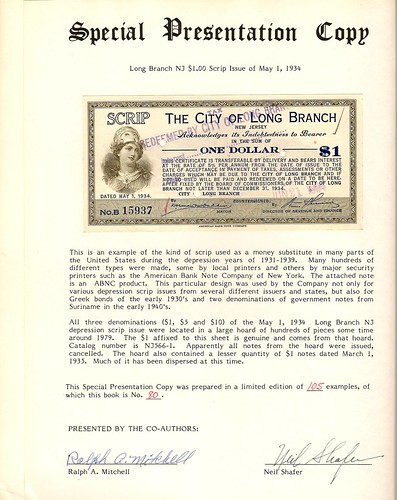
EDITORIAL PRESSURE MOUNTS TO ELIMINATE THE CENT
Those writers in support of keeping the cent in circulation give reasons that have all been disproven. Namely, rounding off to the nearest coin in circulation makes sense, but they cling to the notion every seller will round up for an unearned windfall profit -- small amounts with each transaction that mount to big money in total. A university study proved it would balance out, costing an average family less than $2 a year.
There are only two logical reasons for keeping the cent in circulation -- sentimentality and inertia. We have always had a cent in circulation since 1792, we want to keep it because we like it. Well, those reasons are costing America $98 million in direct costs and close to $500 million in indirect costs. I could get very sentimental about saving those amounts.
One of the best articles I encountered this week was a blog by "Hank" who made many salient points. One, he stated, the Army and Air Force Exchange Services around the world (which operates a military Walmart) no longer stock or accept cents. To heavy to ship overseas. Purchases are rounded off to nearest nickel.
Hank also noted the Illinois delegation in Congress is hesitant to drop Abraham Lincoln, since they represent Abe's home state. Hank cited there are 31 cities and towns across America, six mountains, an aircraft carrier and a submarine all named after the 16th president. Besides, he is still on the five-dollar bill. We are not likely to forget Lincoln .
Of more influential documentation was a statement this week by Richard M. Geerdes, the president of the National Automatic Merchandising Association -- the vending machine trade association. In answer to an illogical editorial in the Atlanta Constitution by a Richard Miniter, who wanted to keep the cent and eliminate the dollar coin, Geerdes ticked off a number of facts.
He repeats the GAO estimated savings using dollar coins instead of dollar bills would be $522 million. Coins last 30 years, paper dollars last 2 years. The vending machine guru -- who should know -- further stated:
"Coins work virtually 100 percent of the time, while many thousands of vending machine sales are thwarted every day by low quality $1 bills.
"Up to half of vending machine operators' service calls are due to jammed bill acceptors. Dollar coins would reduce service calls. And dollar coins are much cheaper to dispense in change than dollar bills."
To read Geerdes full statement click on: National Automatic Merchandising Association Responds To Newspaper Attack On Dollar Coin Or, if you would like to read more what Hank had to say, see: How Much Is A Penny Really Worth?
WAYNE'S NUMISMATIC DIARY, DECEMBER 14, 2008
I managed to squeeze in two numismatic events this week. The first was Tuesday evening, where I attended the holiday dinner of Nummis Nova, my numismatic social group. It was an opportunity to meet member's spouses and enjoy a great leisurely meal. My own wife Dee had to beg off though, having spent the day chaperoning our son Tyler's 3rd-grade class on a field trip to the U.S. Supreme Court and the U.S. Capitol building.Bill Eckberg, Julian Leidman, Joe Levine, David Schenkman and Wayne Herndon were there with their wives, and Traci Poole bought as her guest Mike Ellis of Dominion Grading Service. It was a pleasant surprise to see Mike, who'd driven from Virginia Beach for the event. He, Traci, me, and Wayne and Karin Herndon hung around and chatted for some time after dinner.
One thing Wayne and I had to discuss was my other numismatic event this week. On Saturday, I hosted a program for kids at the Annandale, VA coin show the Wayne runs. It was the first time we'd done anything like that here. I was hoping to model it after the success we had with the Coins4Kids programs at the Pennsylvania Association of Numismatists shows in Pittsburgh.
When I arrived at the show around 1pm Saturday, Wayne was skeptical about whether we'd have any attendees. He'd talked it up all morning to kids at the show, but everyone had other plans for the afternoon, everything from basketball games to birthday parties. While I was prepared for a low turnout I hoped for the best. Later, Karin told me how she'd rolled her eyes as I arranged a dozen+ chairs for the audience.
Well, we needn't have worried. Wayne rounded up a new batch of kids and by the 1:30 starting time the chairs were filling up. By the time we got rolling it was standing room only, with about 30 kids and parents in the room. It was a great bunch of kids - thirteen boys and one girl. They were eager to raise their hands to answer my numismatic quiz questions, and had a number of great coin questions of their own. One asked who's idea it had been to start the 50 States Quarter series, and I talked about David Ganz and his efforts to inspire Congress to action.
Their questions and my prepared talk (a set of slides I prepared back in 2002 for a Coins4Kids meeting) prompted me to discuss topics as diverse as type coin collecting, coin designers, coin investing, and the new 2009 Lincoln Cent designs. One of the kids knew about the 1913 Liberty Nickel, and I digressed into the story of the missing McDermott specimen, and how my friend Eric Newman had once owned all five.
Along the way I distributed donated books and coins to the kids - thanks to Dave Schenkman and others who volunteered material. I was very pleased with the turnout and response. As with PAN we collected names and addresses for a mailing list, and we'll send postcards to all the kids, inviting them and their friends to the next event. Afterwards me, Traci and Karin made plans for the next one, where we hope to add an auction.
If any of our readers have numismatic items they'd care to donate for the kids, please email me (whomren@gmail.com) or see Wayne Herndon at an upcoming coin show. Worn U.S. type coins are ideal, as are raggedy U.S. Fractional Currency or Colonial notes. Off-center cents and nickels are very desirable, as are bulk lots of low-value foreign coins and paper money. Watch your wallet for Star notes - these are a great way to introduce kids to U.S. paper money. Thanks!
NEW CURRENCY AND COINS MUSEUM BEING BUILT IN INDIA
The museum will be a revamped structure in the Old Mint Complex, declared a prime heritage structure by the Kolkata Municipal Corporation. A sum of Rs. 147 crore has been earmarked for the project, slated for completion by September 2011.
A consortium of firms consisting of Eden Infra Projects Private Limited and the U.S.-based D&F Construction Group and Ehrenkrantz Eckstut & Kuhn Architects will implement the project on a public-private partnership with the Government of India.
A testimony to the dominance of colonial architecture sheathed over a replica of Greek Art, the Old Mint was on the verge of collapse.
The Old Mint Complex dates back to 1824, after which the Silver Mint was opened for production on August 1, 1829. Silver coin minting ceased in 1952 and thereafter it functioned as a silver refinery also stopped operations in 1972. The silver reserves were transferred to the new mint at Taratala in 1985.
To read the complete article, see Foundation stone laid for currency museum (http://www.hindu.com/2008/12/09/stories/2008120961712000.htm)
ZIMBABWE TO ISSUE YET ANOTHER NEW HIGH-DENOMINATION NOTE
The half-billion note, worth about 10 US dollars, was released together with a Z$200m bill, which the central bank said was introduced for the “convenience” of the public. They brought the number of new bills put into circulation this year to 29. Last week a Z$100m bill was introduced; at the time it was US$14 or about R140. One week later, it’s worth less than R5.
Zimbabwe’s highest inflation was last estimated in July at 231 million percent but is now believed to be much higher. Due to currency shortages, cash can now only be withdrawn once a week from banks.
To read the original article, see: Hyper-inflation forces Zim to introduce Z500m banknote (http://www.dispatch.co.za/article.aspx?id=279566)
U.S. TREASURY TO ISSUE AUTOMAKER CASHBACK NOTES
Roger deWardt Lane of Hollywood, Florida writes: "This was read at our local coin club Holiday Banquet last week. I'm not sure how it went over, as not all coin collectors and dealers read the papers or watch TV news."So they announced that instead of doing like Argentina and adding more zeros, they are going to change the Treasury Seal to the logos of GM, Chrysler and Ford and print this new money as "CASHBACK NOTES". Then when you buy that new Ford and get $2,500 cash back, they will give you 25 of the new notes. They hope you will just save a few of the CASHBACK NOTES and the government will never have to make them good!
FEATURED WEB SITE: NUMISMATIC CRIMES
This week's Featured Web Site is the Numismatic Crime Information Center set up by Doug Davis, the former Chief of Police in Pantego, Texas.From the web site:
Recognized as an expert in numismatic investigations Doug developed the first and only accredited law enforcement school dealing with the investigation of numismatic crimes and continues to assist state, federal and local law enforcement agencies across the country. The American Numismatic Association has recognized Doug for his numismatic investigations and in 1988 was presented the PNG Sol Kaplan award for setting up a clearinghouse to coordinate investigations of crimes against the numismatic industry.
www.numismaticcrimes.org

